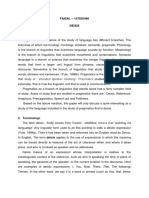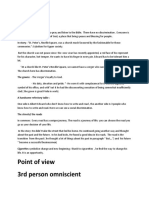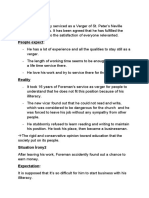0 ratings0% found this document useful (0 votes)
488 viewsThe Hierarchical Structure of Words
The Hierarchical Structure of Words
Uploaded by
Vy PhươngThe document discusses the hierarchical structure of words. Words have a layered structure, with morphemes organized in a systematic linear order but also forming nested constituents. To fully represent a word's structure, we must indicate the root, derivational affix meanings, and part of speech. This additional information shows words have a two-dimensional hierarchical structure rather than just a linear string of morphemes. A labeled branching tree is the best representation to show the nested relationships within a word's morphology.
Copyright:
© All Rights Reserved
Available Formats
Download as DOC, PDF, TXT or read online from Scribd
The Hierarchical Structure of Words
The Hierarchical Structure of Words
Uploaded by
Vy Phương0 ratings0% found this document useful (0 votes)
488 views2 pagesThe document discusses the hierarchical structure of words. Words have a layered structure, with morphemes organized in a systematic linear order but also forming nested constituents. To fully represent a word's structure, we must indicate the root, derivational affix meanings, and part of speech. This additional information shows words have a two-dimensional hierarchical structure rather than just a linear string of morphemes. A labeled branching tree is the best representation to show the nested relationships within a word's morphology.
Original Description:
Original Title
The hierarchical structure of words
Copyright
© © All Rights Reserved
Available Formats
DOC, PDF, TXT or read online from Scribd
Share this document
Did you find this document useful?
Is this content inappropriate?
The document discusses the hierarchical structure of words. Words have a layered structure, with morphemes organized in a systematic linear order but also forming nested constituents. To fully represent a word's structure, we must indicate the root, derivational affix meanings, and part of speech. This additional information shows words have a two-dimensional hierarchical structure rather than just a linear string of morphemes. A labeled branching tree is the best representation to show the nested relationships within a word's morphology.
Copyright:
© All Rights Reserved
Available Formats
Download as DOC, PDF, TXT or read online from Scribd
Download as doc, pdf, or txt
0 ratings0% found this document useful (0 votes)
488 views2 pagesThe Hierarchical Structure of Words
The Hierarchical Structure of Words
Uploaded by
Vy PhươngThe document discusses the hierarchical structure of words. Words have a layered structure, with morphemes organized in a systematic linear order but also forming nested constituents. To fully represent a word's structure, we must indicate the root, derivational affix meanings, and part of speech. This additional information shows words have a two-dimensional hierarchical structure rather than just a linear string of morphemes. A labeled branching tree is the best representation to show the nested relationships within a word's morphology.
Copyright:
© All Rights Reserved
Available Formats
Download as DOC, PDF, TXT or read online from Scribd
Download as doc, pdf, or txt
You are on page 1of 2
The Hierarchical Structure of Words
1. Morphemes within words
morphemes in words have a strict and systematic linear order
consider the morphological structure of fiendishness under this definition:
fiend + -ish + -ness
within words, morphemes are also organized in highly patterned ways
words have an obvious linear order, but they also have a layered structure
fiend + -ish fiendish + -ness fiendishness
( ( (fiend) + -ish) + -ness)
2. Representing the hierarchical structure of words
in order to provide a more complete representation of the structure of a word,
we need to take into account the following:
the fact that every simple word contains one root
the meanings of the derivational affixes in the word
the fact that each lexical item represents a particular part of speech
we can convey this additional, necessary information by labeling the
parentheses around each and every constituent
(( (( fiend)Root + ( -ish )DA)Adjective + ( -ness )DA) Noun
this additional structure is a consequence, as we saw above, of the recursive
application of derivational rules with the result that lexical items may be
embedded in other lexical items.
the internal structure of words is not a one-dimensional string of morphemes but
a two dimensional hierarchy of related constituents
nested parentheses are one way of representing hierarchical structures of this
sort, but they have the disadvantage of looking linear
an alternative representation which makes the hierarchy more apparent is a
branching tree
fiendishness
fiendish -ness
fiend -ish
the appropriate representation for the morphological structure of words is
a labeled branching tree
fiendishnessnoun
fiendishadjective -ness DA
fiendroot -ish DA
You might also like
- Sentence Structure ConstituentsDocument54 pagesSentence Structure ConstituentsVy Phương67% (3)
- 201fall Extra Syntax Practice AK1Document4 pages201fall Extra Syntax Practice AK1Vy PhươngNo ratings yet
- FunctionalismDocument17 pagesFunctionalismCristine Hazel SiclotNo ratings yet
- Phonological Contrastive Analysis of Arabic, Turkish and EnglishDocument9 pagesPhonological Contrastive Analysis of Arabic, Turkish and EnglishMorteza YazdaniNo ratings yet
- Morphological Structure of English WordsDocument14 pagesMorphological Structure of English WordsAndy RayNo ratings yet
- Semantic Competence and TS LatestDocument23 pagesSemantic Competence and TS LatestAisha FaridNo ratings yet
- Open Class ItemsDocument17 pagesOpen Class ItemsravasrbNo ratings yet
- Lecture 12Document34 pagesLecture 12airies92No ratings yet
- Morphological SystemsDocument12 pagesMorphological SystemsShafiq KhanNo ratings yet
- Exercises For Week 7Document16 pagesExercises For Week 7Daniella utamiNo ratings yet
- Grammatical Categories & Word ClassesDocument45 pagesGrammatical Categories & Word Classesaila unnie100% (1)
- Morpheme: 1 Classification of MorphemesDocument4 pagesMorpheme: 1 Classification of Morphemesnero daunaxilNo ratings yet
- English Syntax 2 - Representinf Sentence StructureDocument14 pagesEnglish Syntax 2 - Representinf Sentence StructureArafiqIsmailNo ratings yet
- Langue and ParoleDocument1 pageLangue and ParoleZara NurNo ratings yet
- Systemic Grammar (Eng115) Powerpoint PresentationDocument10 pagesSystemic Grammar (Eng115) Powerpoint PresentationheartstringkoreanNo ratings yet
- 3 (1) (1) - Types and Dimensions of MeaningDocument8 pages3 (1) (1) - Types and Dimensions of Meaningblu3eyes15No ratings yet
- MIDTERM EXAM-linguisticsDocument3 pagesMIDTERM EXAM-linguisticsPepitoNo ratings yet
- Lecture 1 Sense Relations - Lecture NotesDocument2 pagesLecture 1 Sense Relations - Lecture NotesMihaela Codrina AntonNo ratings yet
- The Hierarchical Structure of WordsDocument9 pagesThe Hierarchical Structure of WordsnooraNo ratings yet
- Theories of Language AcquisitionDocument16 pagesTheories of Language AcquisitionAhmad BilalNo ratings yet
- Reflection - Linguistic TreatisesDocument70 pagesReflection - Linguistic TreatisesLinguistic Forum - A Journal of LinguisticsNo ratings yet
- Syntactic AnalysisDocument21 pagesSyntactic Analysissandrago75No ratings yet
- Lesson 2: Kinds of MorphemesDocument13 pagesLesson 2: Kinds of MorphemesMarlon James TobiasNo ratings yet
- Binding Quiz AnswersDocument10 pagesBinding Quiz AnswersDanilo G. BaradilloNo ratings yet
- Semantic TheoriesDocument6 pagesSemantic TheoriesPatience OmondiNo ratings yet
- Phonological Analysis Revised Paper FinalDocument17 pagesPhonological Analysis Revised Paper FinalGlenda PapelleroNo ratings yet
- 1.1. RegisterDocument5 pages1.1. RegisterMercé Perez AparicioNo ratings yet
- Major FinalDocument200 pagesMajor Final红气球No ratings yet
- Graphetic Substance Or, Substance.: Maggie and Milly and Molly and May (Deviation)Document16 pagesGraphetic Substance Or, Substance.: Maggie and Milly and Molly and May (Deviation)ReghieNo ratings yet
- Task 2 - The Nature of Linguistics and LanguageDocument13 pagesTask 2 - The Nature of Linguistics and LanguageViviana FlorezNo ratings yet
- Daniel VandervekenDocument25 pagesDaniel VandervekenFabio_Salgado100% (1)
- English Language Teaching Methods: PPG215 Semester 1, 2014/2015Document41 pagesEnglish Language Teaching Methods: PPG215 Semester 1, 2014/2015mrajisNo ratings yet
- Halliday's Categories in GrammarDocument5 pagesHalliday's Categories in GrammarGlittering FlowerNo ratings yet
- Binding TheoryDocument30 pagesBinding TheorySuliemanNo ratings yet
- Chapter 13: First Language AcquisitionDocument2 pagesChapter 13: First Language AcquisitionJazz CarbajalNo ratings yet
- MorphologyDocument30 pagesMorphologyAnu Shrre100% (1)
- Vowels and Consonants SummaryDocument3 pagesVowels and Consonants SummarySarah KhadijahNo ratings yet
- Gramatical CategoryDocument10 pagesGramatical CategoryAna Karem Kashmir DelgadoNo ratings yet
- Stylistics SyllabusDocument5 pagesStylistics SyllabusCrystalVelezNo ratings yet
- Socio PsychoDocument43 pagesSocio PsychoVicky AullakhNo ratings yet
- QuizDocument10 pagesQuizANo ratings yet
- An X-Bar Theoretic AccountDocument14 pagesAn X-Bar Theoretic AccountSamuel Ekpo100% (1)
- Factors Affecting Sla LearningDocument15 pagesFactors Affecting Sla LearningFrance LomerioNo ratings yet
- Introduction To Morphology Histroy and DefinitionDocument14 pagesIntroduction To Morphology Histroy and Definitionnkhryh_No ratings yet
- Chapter 4 Semantic Roles - NOTESDocument2 pagesChapter 4 Semantic Roles - NOTESWaad Majid100% (1)
- Functional PhonologyDocument20 pagesFunctional PhonologyAhmed MubarakNo ratings yet
- Quiz 2 Discourse AnalysisDocument5 pagesQuiz 2 Discourse AnalysisFia eka100% (1)
- Lexi C OgraphyDocument13 pagesLexi C OgraphyLovelyn Maristela100% (1)
- The Notion of CorrectnessDocument23 pagesThe Notion of CorrectnessAtiqah Hamid80% (5)
- Properties of Human LanguageDocument17 pagesProperties of Human LanguageVenera Moldakulova100% (1)
- DeixisDocument4 pagesDeixisArif WahidinNo ratings yet
- Structural Linguistics: Saussure'S Theory Key ConceptsDocument33 pagesStructural Linguistics: Saussure'S Theory Key ConceptsMarianaNo ratings yet
- Noun VocabularyDocument19 pagesNoun VocabularySumayyah AhmadNo ratings yet
- Theory of SemanticsDocument13 pagesTheory of SemanticsBryce Ventenilla100% (1)
- Clipping: Examples and ObservationsDocument2 pagesClipping: Examples and ObservationsDani Silva100% (1)
- Morphology, Part 1Document4 pagesMorphology, Part 1Ian BlankNo ratings yet
- Language and SocietyDocument13 pagesLanguage and SocietyMasum RahmanNo ratings yet
- Midterm ExamDocument6 pagesMidterm ExamlauraNo ratings yet
- LinguisticsDocument11 pagesLinguisticsAntoneth AlviolaNo ratings yet
- Phrase Structure RulesDocument3 pagesPhrase Structure RulesYue Makino100% (1)
- The Hierarchical Structure of Words: Root DA Adjective DA NounDocument8 pagesThe Hierarchical Structure of Words: Root DA Adjective DA NounAngelica Sevilleno UgdaminaNo ratings yet
- Word-Formation (Word Derivation) : Grigoryeva MDocument30 pagesWord-Formation (Word Derivation) : Grigoryeva MArmine SuvaryanNo ratings yet
- IELTS Mock Test 2017 - FebruaryDocument20 pagesIELTS Mock Test 2017 - FebruaryVy PhươngNo ratings yet
- Oh My GoshDocument4 pagesOh My GoshVy PhươngNo ratings yet
- Sample End Test On Phonetics 1Document6 pagesSample End Test On Phonetics 1Vy PhươngNo ratings yet
- What Are Textbooks ProvidingDocument6 pagesWhat Are Textbooks ProvidingVy PhươngNo ratings yet
- Homework - Listening AssessmentDocument2 pagesHomework - Listening AssessmentVy PhươngNo ratings yet
- Ii. Child-Centered ApproachesDocument12 pagesIi. Child-Centered ApproachesVy PhươngNo ratings yet
- Detached Communication StyleDocument1 pageDetached Communication StyleVy PhươngNo ratings yet
- English For Young Learners: Dinda Athari Haeny Dede Putra Andika Musfera Nara Vadia Aisyah Nasution Della OferischaDocument22 pagesEnglish For Young Learners: Dinda Athari Haeny Dede Putra Andika Musfera Nara Vadia Aisyah Nasution Della OferischaVy PhươngNo ratings yet
- The /TƩ/ Sound: Unit 34 - Pronunciation SkillDocument8 pagesThe /TƩ/ Sound: Unit 34 - Pronunciation SkillVy PhươngNo ratings yet
- wf001 Word FormationDocument2 pageswf001 Word FormationVy PhươngNo ratings yet
- BLOCKS of CULTUREDocument17 pagesBLOCKS of CULTUREVy PhươngNo ratings yet
- wf019 Nouns Verbs Adjectives PDFDocument2 pageswf019 Nouns Verbs Adjectives PDFAna García100% (2)
- Point of View 3rd Person OmniscientDocument2 pagesPoint of View 3rd Person OmniscientVy PhươngNo ratings yet
- On The Cover: Leaders FeaturesDocument27 pagesOn The Cover: Leaders FeaturesVy PhươngNo ratings yet
- Summary of The VergerDocument2 pagesSummary of The VergerVy PhươngNo ratings yet
- 1.situation Irony 1Document3 pages1.situation Irony 1Vy PhươngNo ratings yet
- Schedule MondayDocument1 pageSchedule MondayVy PhươngNo ratings yet














































































